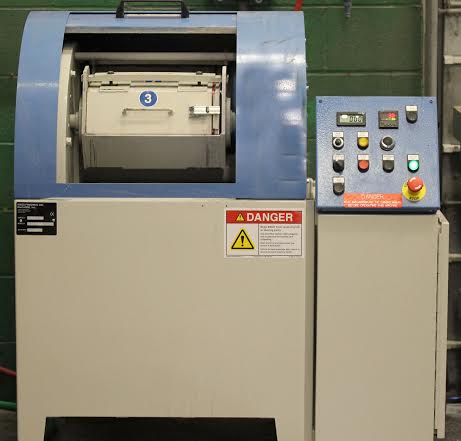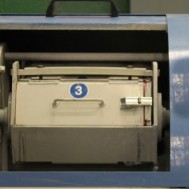Apple Rubber prides itself on continually refining its processes. With the help of expert engineers, we never stop striving for improvements—but where would we be without our machines and advanced technology?
Recently, we got our hands on a new deflashing device.
Meet the latest addition to our roster, a barrel finishing machine—top-of-the-line deflashing to help us continue putting out efficient products.

The new machine appears as a large spinning part. According to Mike Tranquilli, manufacturing manager, the high-energy finishing device works just like a ferris wheel.
“The entire machine rotates, and then there are four barrels inside of it which rotate as well,” said Tranquilli. “We put the parts to be finished in the media solution, inside of each barrel. The energy created from the rotation rubs against the parts and scrubs off any flash, also polishing the parts’ surfaces.”
If you remember from our previous post featuring Dave Meehan, deflashing allows us to remove any extra material in the slitting and trimming process. It’s a crucial step when it comes to precision.
“It’s not an issue for all customers, but for some, we are finding that they are looking for parts without any parting line—those can occur with a two-part mold,” said Tranquilli.
With the new finishing machine, we have the ability to polish down the parts (typically O-Rings) and minimize any sign of the parting line or flash that the cryogenic equipment could not remove.
Diversity in Deflashing
Our processes constantly need tweaking and customization. In deflashing, for example, sometimes parts need something more abrasive to remove the wrapped flash. With a developed machine such as this, we can give those particular customers a smooth surface on their finished part.
There are several cases where customers will need a tailor-made finishing process.
“We’ll run into issues with customers for whom we’ve provided a great part, but they can’t feed it into their equipment,” said Tranquilli. “In situations like this, we always want to help find a solution.”
With our deflashing machine, we can also rough up the surface of the parts. Some materials—such as silicone–can be tacky or sticky. They may have trouble sliding through the feeding assembly. Between this device and the roughing, we break up the surface tension.
No matter the material, this process can make the parts easily able to move down any tracks or rails during the assembly process. It answers our questions, but more importantly, it answers our customers’ questions too.
“We always want to be part of the solution for our customers,” Tranquilli noted. “Machines like this will allow us to produce the part that meets their needs.”
